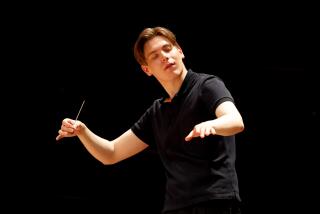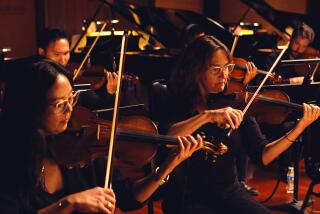Malibu Pianist Von Oeyen Plays to the Promise of Future
- Share via
The promise of Andrew von Oeyen, a 19-year-old pianist from Malibu, has been recognized for some time locally. He has grown up performing in a number of venues around town, and three years ago he was spotlighted by the Los Angeles Philharmonic as a young musician to watch. Later this season he will be a soloist with L.A.’s American Youth Orchestra.
Now a student at the Juilliard School in New York, he has captured wider attention: Last month he was awarded the Gilmore Young Artist Award. The prize--a $15,000 grant and concert appearances--is given every other year to pianists under 22. It is not a competition; rather, its judges secretly scrutinize pianists they feel are of exceptional interest.
It is a good award; and Von Oeyen was, on evidence of a recital in the Zipper Concert Hall of the Colburn School on Sunday afternoon, a good choice. Von Oeyen had a young player’s typically ambitious program, but he did not perform it like a typical competition winner. He is not an interpreter mature beyond his years. In music of seriousness and depth--he began the recital with the Busoni arrangement of Bach’s D-Minor Chaconne and Chopin’s Third Piano Sonata--his playing is still finger-driven.
It does not yet have a preciously finished quality. He is studied, precise and sober, more logical and pianistic than poetic. But that seemed just right for a pianist of his age, building a foundation upon which to grow rather than reaching artificial interpretive solutions too early.
After intermission, Von Oeyen played Ligeti’s “Musica Ricercata,” and suddenly everything--physicality, focused energy, personality, a sense of humor--clicked. Written in the early ‘50s by the Hungarian composer when he was still in his 20s, this is a series of 11 nutty etudes that were obscure until recently when Stanley Kubrick found in one of them a rhythmic obsessiveness suitable for the icy eroticism of “Eyes Wide Shut.”
The first etude uses only two notes, and an additional note of the chromatic scale is added in each of the subsequent 10. The limited use of pitch in the first few drove Ligeti into unconventional uses of tone color and percussive rhythmic effects to keep the music interesting and unpredictable, but once he’d begun that path his only solution was to get weirder as more pitches appeared.
This is music that sounds like a machine going out of control in all kinds of interesting ways, and Von Oeyen took delight in producing the powerful mechanistic sound and in the musical derailments the Ligeti sets up.
The final piece, Prokofiev’s aggressive Seventh Sonata, was written 10 years earlier than Ligeti’s etudes and is another exercise in a kind of motoric insanity, but in this case that of wartime Russia. Von Oeyen’s was a single-minded approach, in which the galloping finale, one of the great showpieces of 20th century piano writing, sounded like the reasonable resolution of tensions rather than a complete breaking free of emotions. But that hardly stopped it from bringing the house down. There is in Von Oeyen a refreshing sense of a gifted young musician slowly, methodically discovering music. It will be a rewarding career to follow.
More to Read
The biggest entertainment stories
Get our big stories about Hollywood, film, television, music, arts, culture and more right in your inbox as soon as they publish.
You may occasionally receive promotional content from the Los Angeles Times.











